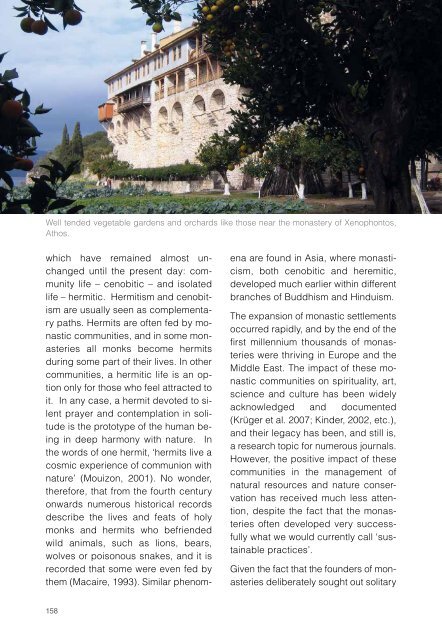The Diversity of Sacred Lands in Europe - IUCN
The Diversity of Sacred Lands in Europe - IUCN
The Diversity of Sacred Lands in Europe - IUCN
You also want an ePaper? Increase the reach of your titles
YUMPU automatically turns print PDFs into web optimized ePapers that Google loves.
Well tended vegetable gardens and orchards like those near the monastery <strong>of</strong> Xenophontos,<br />
Athos.<br />
which have rema<strong>in</strong>ed almost unchanged<br />
until the present day: community<br />
life – cenobitic – and isolated<br />
life – hermitic. Hermitism and cenobitism<br />
are usually seen as complementary<br />
paths. Hermits are <strong>of</strong>ten fed by monastic<br />
communities, and <strong>in</strong> some monasteries<br />
all monks become hermits<br />
dur<strong>in</strong>g some part <strong>of</strong> their lives. In other<br />
communities, a hermitic life is an option<br />
only for those who feel attracted to<br />
it. In any case, a hermit devoted to silent<br />
prayer and contemplation <strong>in</strong> solitude<br />
is the prototype <strong>of</strong> the human be<strong>in</strong>g<br />
<strong>in</strong> deep harmony with nature. In<br />
the words <strong>of</strong> one hermit, ‘hermits live a<br />
cosmic experience <strong>of</strong> communion with<br />
nature’ (Mouizon, 2001). No wonder,<br />
therefore, that from the fourth century<br />
onwards numerous historical records<br />
describe the lives and feats <strong>of</strong> holy<br />
monks and hermits who befriended<br />
wild animals, such as lions, bears,<br />
wolves or poisonous snakes, and it is<br />
recorded that some were even fed by<br />
them (Macaire, 1993). Similar phenomena<br />
are found <strong>in</strong> Asia, where monasticism,<br />
both cenobitic and heremitic,<br />
developed much earlier with<strong>in</strong> different<br />
branches <strong>of</strong> Buddhism and H<strong>in</strong>duism.<br />
<strong>The</strong> expansion <strong>of</strong> monastic settlements<br />
occurred rapidly, and by the end <strong>of</strong> the<br />
first millennium thousands <strong>of</strong> monasteries<br />
were thriv<strong>in</strong>g <strong>in</strong> <strong>Europe</strong> and the<br />
Middle East. <strong>The</strong> impact <strong>of</strong> these monastic<br />
communities on spirituality, art,<br />
science and culture has been widely<br />
acknowledged and documented<br />
(Krüger et al. 2007; K<strong>in</strong>der, 2002, etc.),<br />
and their legacy has been, and still is,<br />
a research topic for numerous journals.<br />
However, the positive impact <strong>of</strong> these<br />
communities <strong>in</strong> the management <strong>of</strong><br />
natural resources and nature conservation<br />
has received much less attention,<br />
despite the fact that the monasteries<br />
<strong>of</strong>ten developed very successfully<br />
what we would currently call ‘susta<strong>in</strong>able<br />
practices’.<br />
Given the fact that the founders <strong>of</strong> monasteries<br />
deliberately sought out solitary<br />
158













